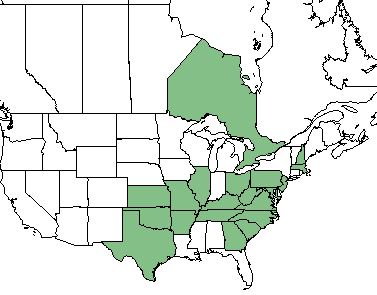Difference between revisions of "Scleria pauciflora"
(→Ecology) |
(→Conservation and Management) |
||
| Line 42: | Line 42: | ||
==Conservation and Management== | ==Conservation and Management== | ||
| + | ''S. pauciflora'' is classified as endangered in Massachusetts and Michigan. It is considered threatened in Ohio, Pennsylvania, and Rhode Island. <ref name= "USDA"> [https://plants.usda.gov/core/profile?symbol=CEAM USDA Plant Database]</ref> | ||
==Cultivation and restoration== | ==Cultivation and restoration== | ||
Revision as of 14:56, 29 May 2018
| Scleria pauciflora | |
|---|---|

| |
| Photo by John Gwaltney hosted at Southeastern Flora.com | |
| Scientific classification | |
| Kingdom: | Plantae |
| Division: | Magnoliophyta - Flowering plants |
| Class: | Liliopsida - Moncots |
| Order: | Poales |
| Family: | Cyperaceae |
| Genus: | Scleria |
| Species: | S. pauciflora |
| Binomial name | |
| Scleria pauciflora Muhl. ex Willd. | |

| |
| Natural range of Scleria pauciflora from USDA NRCS Plants Database. | |
Contents
Taxonomic Notes
Synonym: S. ciliata
Variety: S. paciflora var. caroliniana
Description
S. pauciflora is a perennial graminoid of the Cyperaceae family that is native to North America. [1]
Distribution
S. pauciflora is found in the majority of the western United States; Georgia, South Carolina, Virginia, Maryland, Delaware, New Jersey, West Virginia, Pennsylvania, Massachusetts, New Hampshire, Ohio, Tennessee. Kentucky, Illinois, Missouri, Arkansas, Kansas, Oklahoma, and Texas, as well as Ontario, Canada. [1]
Ecology
Habitat
S. pauciflora is found in habitats such as wet and dry pine flatwoods, pine savannas, and depression meadows. [2]
Conservation and Management
S. pauciflora is classified as endangered in Massachusetts and Michigan. It is considered threatened in Ohio, Pennsylvania, and Rhode Island. [1]
Cultivation and restoration
Photo Gallery
References and notes
- ↑ 1.0 1.1 1.2 USDA Plant Database
- ↑ Weakley, A. S. (2015). Flora of the Southern and Mid-Atlantic States. Chapel Hill, NC, University of North Carolina Herbarium.